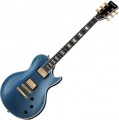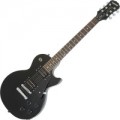Tone controls
The number of tone controls provided in the design of an electric guitar.
One tone control is responsible for the sound of the electric guitar as a whole; but if there are several such pens, they can have different formats of work. So, each knob can be responsible either for its own pickup, or for a separate frequency band. In the second case, a set of knobs plays the role of an equalizer that allows you to adjust the sound by changing the volume of low and high (sometimes even separately middle) frequencies.
Anyway, the presence of several tone controls expands the possibilities for changing the coloring of the sound by means of the guitar itself, without the use of additional equipment.
Pickguard
The presence of a protective lining (pickguard) on the body of the guitar.
Such an overlay is located on the upper deck, most often made of durable plastic and differs markedly in colour, due to which it is clearly visible. Its main purpose is to protect the soundboard surface from pick strikes (for example, when playing with dynamic fighting), which could damage the varnished wooden surface. The specific shape and size of the fingerboard may vary, but anyway, it covers at least the surface below the strings (when looking at the guitar in the working position), and sometimes under the strings and even above them.
Material
The material from which the body of an electric guitar is made. For models with cutouts (semi-acoustic, see "Type"), in this case, only the material of the back deck and sides can be taken into account, and data on the top deck is given separately (for more details, see "Deck Cover Material").
Now on the market there are cases of such trees:
red,
maple,
agatis,
ash,
alder.
It makes no sense to dwell on each of the materials found in modern electric guitars. Their variety is very large, however, unlike acoustic guitars, the body in this case does not play such a significant role in shaping the sound, and its material has a relatively small effect on the acoustic properties of the instrument (although the exact degree of such influence is a moot point). If you wish, you can find detailed data on a particular material in special sources, but in fact it makes sense to look primarily at the appearance of the instrument and its price category.
Neck profile
Profile of a fretboard mounted on an electric guitar.
The profile of the neck is called its shape in section, more precisely, the shape of the back of the neck. This parameter practically does not affect the sound of the guitar, but it directly affects the convenience of playing. Ideally, the neck should “fill” the hand, but not be too large — otherwise it will not be possible to clasp it to the right extent.
Profiles are denoted by the letters C, D, V and U — depending on which letter the neck resembles in the section. Profile D is the flattest, C is slightly more convex, with almost uniform curvature along the entire length, U is more voluminous, with a wider profile in the area of the lining, and the V profile in its classic form has the form of an angle with a rounded top. There are also modifications of these options — for example, "thin", which provides for a reduced profile thickness, or "modern", with slightly improved (theoretically) ergonomics.
The most popular profile types are
C,
U and their "modern" (modern) modifications. The C profile is almost semi-circular, the U profile is more voluminous, at the fingerboard its edges are almost parallel and only closer to the back of the neck are sharply rounded. The terms
modern C and
modern U refer to various improved versions of these profiles, their f
...orm may be different.
In fact, the choice of neck profile depends solely on the guitarist's personal preferences, the characteristics of his hands and his preferred playing technique. Thus, there is no "perfect" profile shape — in each case, the optimal choice will be different. The perfect option is to try several types of profile "live", decide which one will be more convenient, and choose an instrument with a neck of the same or similar profile shape.Fretboard radius
The radius of curvature of a fretboard mounted on the fretboard of an electric guitar.
The fingerboard is located directly under the strings, it is to it that the musician presses the strings when playing. If you look at the neck in cross section, its upper part with the overlay will have the shape of an arc; the radius of this arc is implied in this case. The smaller the radius, the more convex this arc will be, and vice versa, a large radius will correspond to an almost flat surface.
In general, it is believed that a smaller fingerboard radius is better for playing chords, and a more even, flat surface makes it easier to play technical passages with an abundance of special techniques such as bands. The average and, one might say, classic diameter value is 12", this is the most popular option among modern electric guitars. The smallest figure is just over 7", it is found in some guitars with Stratocaster bodies (both original Fender instruments and copies ). And the most flat pads have a diameter of 20" or more.
Note that there are often instruments with a variable fretboard radius — smaller at the headstock (where chords are played more often) and larger near the body (where solos are played by notes). In such cases, the radius at the nut is indicated.
Anchor
The type of truss provided in the design of the neck of an electric guitar.
The anchor has the form of an elastic metal rod installed along the neck and hidden inside. It reinforces the structure and prevents the neck from deforming from string tension. The truss rod can be made adjustable to suit the characteristics of the strings and compensate for the deformations that inevitably occur over time. The types of this detail can be as follows:
- Single. Anchor consisting of a single rod. The classic version used in most modern electric guitars, regardless of price category. Usually, the strength and rigidity of even a single rod is sufficient for normal applications and use.
- Double. Anchor, consisting, in accordance with the name, of two rods. It is distinguished by greater strength and reliability compared to a single one, in particular, it provides additional resistance to lateral deformations. On the other hand, the double construction is noticeably more expensive.
Scale
The scale is the distance from the nut to the bridge; in other words, this is the working length of the open (not pressed with a finger) string. The greater this distance, the more tightly the strings must be stretched to achieve the desired pitch and the greater the force required to press them against the fingerboard. However, some guitarists argue that even a small difference in length - less than an inch - already makes a significant difference in the feel when playing.
In addition, this parameter also affects the color of the sound. A longer length allows you to get a brighter, louder and more expressive sound, while a shorter length allows you to get a denser, “warmer” and smoother sound. Thus, all other things being equal, a relatively short scale length is better for playing chords, while a longer instrument may be needed to achieve the desired sound in a solo.
The most popular scale length options in electric guitars (not basses) are
24.75" (Gibson) and
25.5" (Fender). Indicators less than 22" are extremely rare, mainly in instruments with miniature 3/4" bodies (see "Size"), and the maximum value is about 28", longer instruments are practically not produced. But basses have a noticeably longer length ( otherwise the strings for them would have to be made too thick or tensioned too loosely): the shortest models provide a scale length of 30", but the classic value is
34".
Note that the design of the bridge often allows you to change the actual scale length (including for each string separately); This is done to ensure that the instrument plays accurately along the frets. Therefore, in the characteristics it is customary to indicate the default scale length, without additional adjustments.

